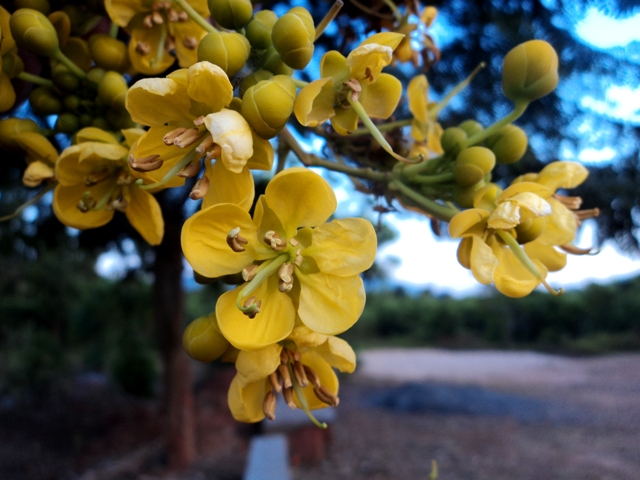Cassia siamea or Senna siamea is also called Siamese Senna, Black-Wood Cassia, Bombay Blackwood, Cassia, Iron Wood, Kassod Tree, Thai Copper, Thai Cassia, and Thailand Shower Pod. It is called Seemia and Kassod in Hindi, Kassod in Marathi, Sima tangedu, Hiretangedi, Motovolanyaro in Kannada , Manjal konrai, Manje-konne, Beati ,Vakai and Chelumalarkkonrai in Tamil Manjakonna, Manjakonnei in Malayalam, Nela thangedu, Sima tangedu, Kurumbi in Telugu. In Oriya we call it Chakunda.
Its botanical name is Cassia siamea (also Cassia florida Vahl, Cassia siamea Lamk. Senna sumatrana Roxb).
C. siamea is native to south and Southeast Asia. It is a medium sized fast-growing perennial tree which rarely exceeds 20 mtrs. in height, with a straight trunk around 30 cm in diameter, with numerous foliage, large spires of yellow blooms, which are followed, in a couple of months, by a crown of red-brown pods. It has a crooked stems, the Bark is gray or light brown, smooth, becoming slightly fissured. Inner bark is light, brown and gritty. The sapwood is light brown and the heartwood dark brown. The wood is heavy and hard. The twigs are greenish and minutely hairy when young, gradually turning brown. Its young branches have fine hairs. The leaves are pinnately compound with an even leaf arrangement of 7-10 pairs of elliptic leaflets 7-8 cm long and 1-2 cm wide. The tree has a dense crown and bears large, attractive bunches of yellow flowers. Its blooming period is July to October. It starts flowering and fruiting at the age of 2-3 years. The fruit is a flat pod 15-25 cm long, thickened at both sutures, containing many beanlike seeds. Once matured, it flowers richly throughout the year. It is normally propagated by seed, and plantations are often established by direct sowing. The tree needs very low maintenance.
The herb has analgesic and anti-inflammatory effects. Kassod has also got medicinal properties which are mentioned in Ayurveda. The fruit is used for treatment intestinal worms in children. The heartwood is used for scabies & rhinitis. Cassia siamea has been evaluated for its potent anti-oxidant activity. The evaluation of the results showed the C. siamea flowers extracts exhibited very potent anti-oxidant action and helped to prevent cell damage due to free radicals and lowers the risks of colorectal cancer. It also prevents oxidative damage to the liver. Whole plant of Cassia Seimia is anti-diabetic.
Young leaves, young fruits and young flowers of C. siamea are popularly used as a vegetable in Sri Lanka and Thailand. The curry promotes sleeping- aid and is also a mild laxative. During preparation the cooking liquid is replaced 3 times to remove bitterness and toxins. The water is then discarded and the boiled leaves are mixed with coconut milk and curry paste and cooked as a curry which is consumed with cooked rice as a food.
C. siamea is widely grown for fodder. The secondary plant compounds in the leaves, flowers and pods are highly toxic to non-ruminants, such as pigs and poultry, as pigs savor the poisonous leaves they should be kept away from these trees. The dense, dark-coloured wood of C. siamea makes good fuel, but the wood produces a lot of smoke. The wood was formerly used for locomotive engines. Its charcoal is also of excellent quality. C. siamea yields a medium-weight to heavy hardwood. The wood is hard to very hard, resistant to termites, strong, durable, and difficult to work, with a tendency to pick up in planing and it takes a high polish. The dark heartwood of C. siamea, which is often nicely figured, is used for joinery, cabinet making, inlaying. The wood has been used for poles, posts, bridges, Boat building (general), Carvings, Charcoal , Musical instruments, Particleboard, Poles, Pulp/Paper products, Sporting Goods, Tool handles, , Veneer decorative, Walking sticks, mine poles, beams, construction, timber, furniture, inlays and fuel wood. All parts of the plant can be used for tanning. The tree has many other uses. It is used extensively for rehabilitation of degraded lands. Its leaves are high in nitrogen content & great as organic manure which provides very useful mulch. Due to its extensive root system, it effectively increases topsoil infiltration, reduces runoff & combats soil erosion. Hence it is widely used as hedgerows, shelterbelts and banks. C. Siamea is grown as a shade tree along roads and in cocoa, coffee and tea plantations. C. siamea is often planted as an ornamental for its abundant yellow flowers.



